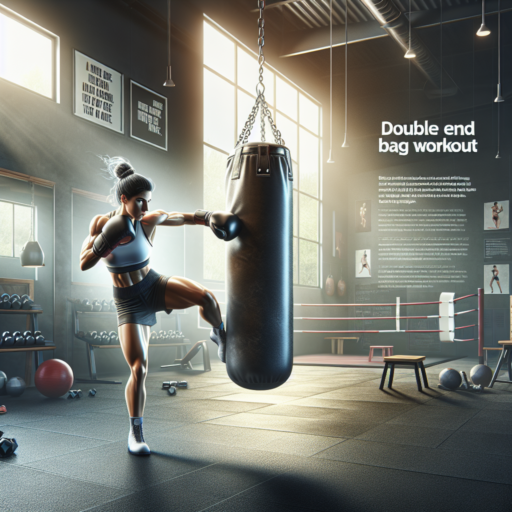Is Double End bag effective?
The effectiveness of a Double End bag in training and boxing drills cannot be overstated. This versatile piece of equipment is designed for accuracy, speed, rhythm, and timing enhancement. Unlike heavy bags, the Double End bag rebounds at a fast pace, mimicking an opponent’s movement and providing a dynamic target for boxers and fitness enthusiasts alike.
Improvement of Punching Precision and Speed
One of the chief benefits of training with a Double End bag is the significant improvement in punching precision and speed. As the bag moves unpredictally upon impact, it forces the user to adjust their timing and aim with each punch. This not only sharpens reflexes but also enhances the ability to hit moving targets with greater accuracy.
Enhanced Defensive Skills
Beyond just offense, the Double End bag plays a critical role in improving a boxer’s defensive skills. The need to continuously anticipate the bag’s movement teaches fighters to stay alert and maintain proper guard. This direct engagement mimics the unpredictability of a real bout, where defensive agility can turn the tide in critical moments.
Overall, the Double End bag is a highly effective training tool that offers a comprehensive workout, focusing on both offensive and defensive boxing techniques. Its role in simulating real-life fighting scenarios helps build endurance, coordination, and the mental acuity required for the ring. Whether you’re a professional boxer or simply looking to enhance your fitness regimen, incorporating a Double End bag can yield significant benefits.
No se han encontrado productos.
How to train a double end bag?
Training with a double end bag is a quintessential part of a boxer’s or martial artist’s regimen, focusing on improving speed, timing, and precision. Whether you’re a beginner or a seasoned fighter, here are some key techniques and tips to enhance your training session.
Setting Up Your Double End Bag
Before diving into the training, ensure your double end bag is set up correctly. It should be tightly secured at both ends, with the bottom end just about at waist level for optimal striking. This position allows for a more realistic simulation of hitting a moving target, akin to an opponent in the ring.
Basic Punches and Combinations
Start with the fundamentals. Use straight punches (jabs and crosses) to get accustomed to the bag’s movement. As your timing improves, integrate hooks and uppercuts. The key is to maintain a rhythm; let the bag dictate your flow to simulate a real fight scenario. Consider implementing combinations like the jab-cross-hook or the uppercut-cross-hook to elevate your precision and power.
Mastering Movement and Timing
Efficient movement around the bag is critical. Don’t just stand in front of it; instead, practice moving in and out, side to side, mimicking ring movement. This is where you sharpen your timing—strike the bag when it comes towards you and move or duck when it swings back. The unpredictability of the bag’s movement enhances your reflexes, making you a harder target in the ring.
Incorporating these strategies into your training regimen will solidify your foundation and develop your skills with a double end bag. Remember, consistency is key to mastering the art of this complex yet rewarding training tool.
What is a double end speed bag?
The double end speed bag stands as a specialized piece of equipment quintessential to the boxing, martial arts, and general fitness communities. Distinguished from its traditional counterpart, the single end speed bag, this variant is anchored at both ends—typical to a floor and ceiling setup—thereby offering a unique blend of stability and reactivity. Its purpose is to sharpen an athlete’s hand-eye coordination, punching speed, reflexes, and overall timing.
Featuring a design that allows for a highly unpredictable rebound effect, the double end speed bag demands and develops a higher level of precision and focus from its users. The distinctive tethering at both ends ensures that the bag returns at varying angles, compelling the practitioner to adjust their stance and punch direction in real-time. This aspect not only enhances cardiovascular fitness but also simulates the dynamic nature of an actual combat scenario, making it an invaluable training tool.
Additionally, the adjustable tension of the cords can be customized to suit different levels of training; a tighter tension results in a faster return, pushing the boundaries of an athlete’s reaction speed and agility. It’s this versatility that makes the double end speed bag a favored choice among professionals and enthusiasts alike, catering to a wide range of skill sets from beginner to advanced levels. The emphasis on speed, accuracy, and adaptability offered by this tool is unparalleled, solidifying its status as a cornerstone in combat sports training regimes.
Should double end bag be tight or loose?
When selecting the appropriate setting for a double end bag, the choice between a tight versus a loose adjustment significantly impacts your training outcomes. The tension of the bag influences not only the speed and rebound precision but also affects how you develop your reflexes, timing, and rhythm. Thus, understanding the intricacies of each setup is crucial for tailoring your training regime to match your skill development goals.
Benefits of a Tight Double End Bag
Opting for a tight adjustment on a double end bag offers faster rebound speeds, making it ideal for advanced practitioners aiming to enhance their hand speed and reaction time. This setting challenges your precision, as the increased tension narrows the margin for error, forcing you to fine-tune your punch accuracy. Additionally, a tightly set bag simulates a more realistic interaction with an opponent, preparing you for high-speed exchanges in real combat situations.
Advantages of a Loose Double End Bag
In contrast, a loose setting on a double end bag caters to developing strategic skills such as timing and rhythm. With a slower rebound, fighters have the opportunity to practice complex combinations, work on their footwork, and better understand the rhythm of a fight. This setting is particularly beneficial for beginners who need to build a solid foundation of skills without the pressure of a rapidly responsive bag.




